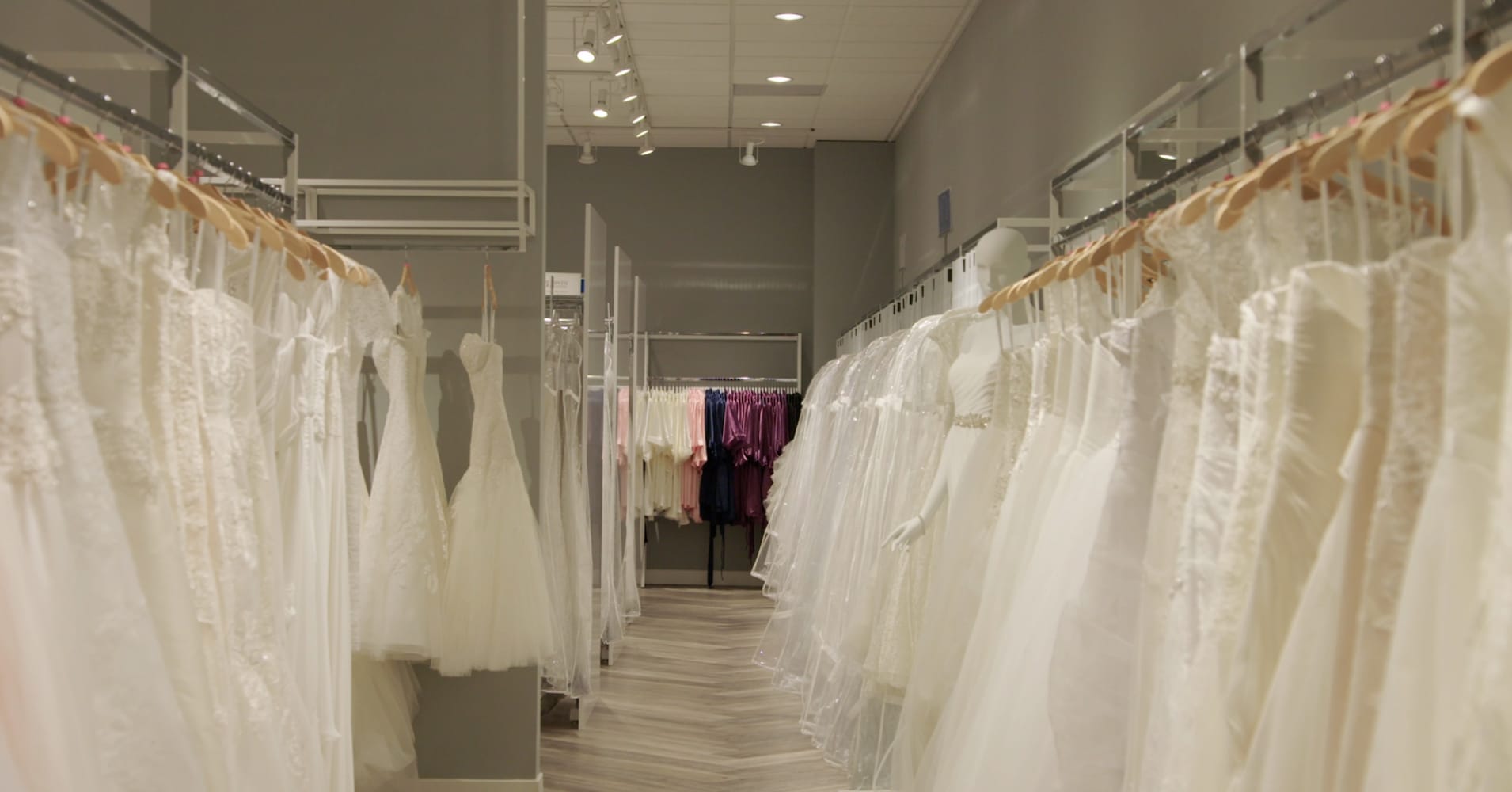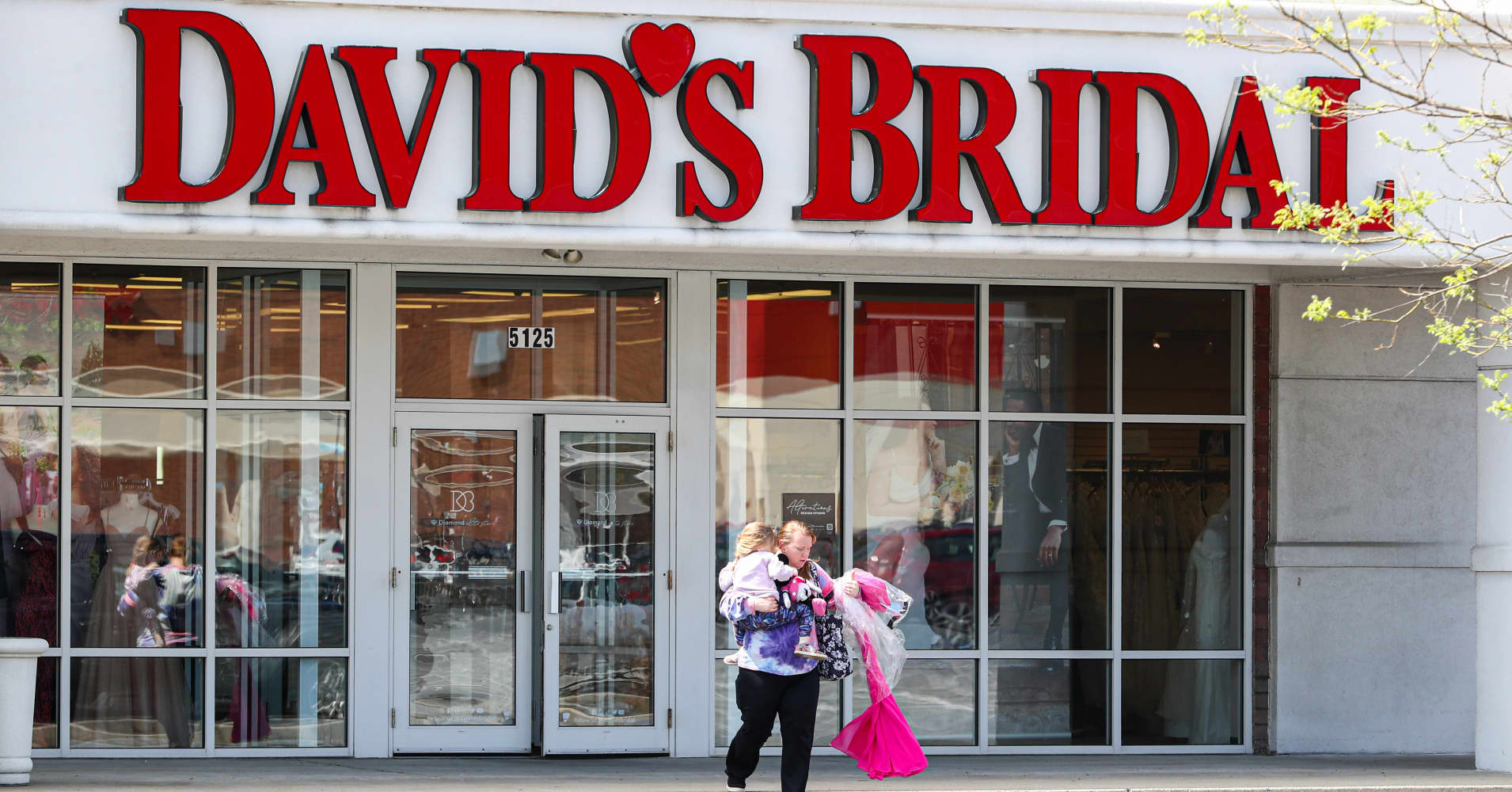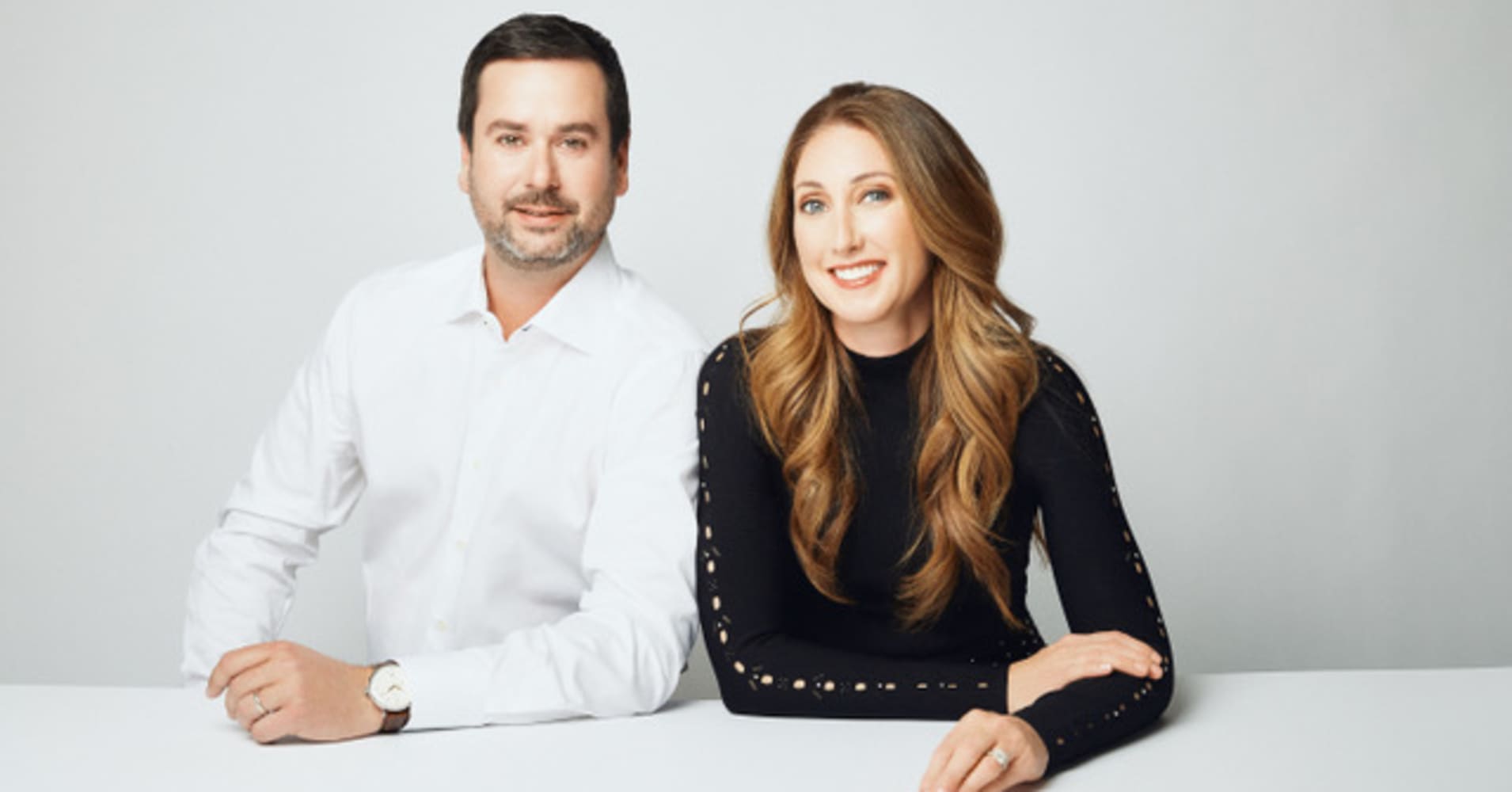Trump's Tariffs on China Are Boosting Wedding Dress Costs and Imperiling Small Boutiques
- Bridal boutiques and wedding dress designers are getting squeezed by steep tariffs on China, which is a major manufacturing hub for bridal and special occasion dresses and accessories.
- Some wedding dress brands, such as Mon Cheri and Justin Alexander, have added tariff surcharges, and others like David's Bridal have rushed to move production out of China.
- The National Bridal Retailers Association, which represents thousands of boutiques across the country, started a letter-writing campaign to lawmakers to speak out against the tariff and ask for an exemption.

Days after President Donald Trump announced steep tariffs on imports from China, Denise Buzy-Pucheu sat on the couch in her bridal boutique and fired up the shop's iPhone.
In a video subsequently uploaded to Instagram, the owner of The Persnickety Bride in Newtown, Connecticut, addressed brides and potential clients directly, explaining how the 145% tariff on goods imported from China would disrupt the wedding industry, particularly their business operations.
Nearly all wedding dresses are produced in China or various regions across Asia, along with much of the fabric, buttons, zippers, and other components used. Expert sewers are scarce in the U.S., typically belonging to older demographics. Producing these garments in other nations, where labor expenses tend to be lower, has made premium quality bridal attire more affordable for numerous American households.
As this kind of work isn’t something you can simply import into the U.S., she explained in the video. “There aren’t enough local technicians available for such tasks.”
The tariffs imposed on Chinese imports have affected numerous everyday items such as T-shirts, outdoor furnishings, infant carriages, and playthings. However, the wedding dress and formal wear industry exemplifies how these levies can harm smaller enterprises deeply integrated into international supply networks.
A significant portion of their sales originates from local stores nationwide that stock wedding dresses, tuxedos, prom outfits, and similar items. These retailers serve clients who have strict timelines, limited finances, and lofty standards, frequently producing personalized orders that are scheduled weeks or even months prior to manufacturing or delivery.
In addition to these factors, the sector remains highly susceptible to tariff impacts. It’s reported that around 90% of wedding gowns are produced in China, based on data from the National Bridal Retailers Association—although an increasing number of companies have shifted production to different Asian countries like Myanmar and Vietnam. This association encompasses roughly 6,000 bridal and formalwear retailers throughout the U.S.

The specific discomfort the sector is experiencing has caused it—as with others significantly affected by tariffs—to advocate for exemptions from these charges. Over the last couple of weeks, the NBRA has been doing this. launched a letter-writing campaign To U.S. Senators and Representatives to encourage policymakers and the White House to permit an exception. The sector is already subject to a tariff that originated during the initial Trump administration, as well as an additional duty.
A spokesperson from the White House did not promptly reply to a request for comments regarding whether Trump would entertain the idea of an exception.
Several prominent figures in wedding dresses started an online petition including Stephen Lang, who founded and leads Mon Cheri, the branding company based in Trenton, New Jersey.
Lang mentioned that the tariffs have been causing him insomnia. He fears that these could lead to shutting down the company with its 120 employees, which he founded in 1991, as well as impacting most of the stores that sell his dresses.
Many of those stores were already struggling to cover expenses like rent and employee wages, he said. And the boutiques' business models have felt squeezed as some customers use them as "try-on shops," only to buy a similar, cheaper alternative online.
He stated that if stores and clothing brands permanently shut down, both the businesses themselves and the tradition of searching for outfits for special events and familial celebrations will vanish.
"The industry will be obliterated if it doesn’t evolve," he stated.
Should tariffs remain at their current levels, small business owners such as Sandra Gonzalez may face difficult decisions. According to Gonzalez, who serves as the VP of NBRA, the prices of dresses in her Sacramento, California store have increased by 5% to 25% due to these tariffs.
Although she hasn't increased the prices yet, she mentioned that she isn't certain for how much longer this delay will be possible.
"It's on a week-by-week basis," Gonzalez said.
Sticker shock for brides
Many brides experience sticker shock when they see wedding dress prices.
In the U.S., brides typically spent around $2,100 on their wedding gown, as reported in the 2025 Real Weddings Study conducted by The Knot—a worldwide enterprise offering various wedding-associated services along with a comprehensive list of wedding suppliers.
Moreover, this isn’t the sole expenditure included. As reported by The Wedding Report, which conducts market research within the sector, the typical amount spent on weddings amounts to approximately $31,428. Other projections suggest an even steeper figure; The Knot indicates that the mean cost stands around $33,000, whereas David’s Bridal approximates it as roughly $37,500 on average.
The financial strain faced by brides has intensified the urgency for bridal shops and designers to devise strategies to cope with increased costs due to tariffs without alienating customers who might be drawn to cheaper online options.

David's Bridal, with almost 200 outlets nationwide, has accelerated its plans to shift all production away from China. This Pennsylvania-based bridal wear business, having faced two bankruptcies before and currently undergoing financial restructuring, aims to relocate its manufacturing operations. in the midst of updating its operations sells wedding dresses with prices ranging from $99 up to around $6,000.
By the close of last year, approximately 48% of the company’s goods were produced in China. The firm plans to shift almost all of its manufacturing outside of China by the end of this year, with new production sites set up in Myanmar, Vietnam, and Sri Lanka, according to CEO Kelly Cook. Goods imported from these alternative locations currently incur significantly lower tariffs compared to Chinese imports—at least as things stand under President Trump. announced a 90-day pause in early April, for certain nations, there were increased tariff rates.
Cook mentioned that the firm managed to deliver 300,000 dresses to the U.S. prior to the implementation of tariffs and has been exploring methods to reduce expenses throughout the organization, like employing advanced AI technologies, ensuring they can avoid increasing their prices.
"The final option, truly our very last choice, would be to pass along a price hike to the customers because of the tariff," she stated.
Surcharges and slowed production
As they face the cost increases, major bridal brands have started to add tariff surcharges, a percentage-based added cost that's typically shared by bridal boutiques and customers.
For instance, Mon Cheri has added a 39% tariff surcharge for retailers. The company has also implemented various measures to control expenses, reducing its production by about half since the tariffs began, according to Lang. Currently, they are only fulfilling necessary orders, like bespoke gowns for particular wedding dates.
Approximately 90% of all goods and around 80% of bridal products are imported by this firm from China. The business offers wedding gowns priced between $500 and $20,000, which are distributed nationwide through specialized retailers.
According to Lang, the additional charge imposed on bridal shops equates to approximately a 15% rise in retail prices for brides. As an illustration, with the typical cost of the company’s wedding gowns being around $2,200, this extra fee would amount to an added $300 for customers purchasing these dresses.
A bridal company based in New Jersey called Justin Alexander has similarly imposed additional tariffs on their gowns, as mentioned by Justin Warshaw, who serves both as the creative director and CEO of the brand. According to him, this adjustment equates to roughly a 6% hike at the point of sale for customers. To illustrate, Mr. Warshaw noted that what was once priced at $2,000 would now be charged at $2,120.
However, he mentioned that the company chose to cover the additional expenses for dresses that brides had ordered prior to when the tariffs started. This choice has the potential to erase their profit margins entirely.
He stated that they learned a bride agreed to the dress at a certain cost.
Approximately half of the company’s output comes from China, with Vietnam accounting for around 45%, and Myanmar making up the remaining 5%, according to Warshaw. The prices of their dresses vary between roughly $1,500 and $12,000.
However, certain designers, bridal gown stores, and businesses mentioned that their strategies might shift if tariff rates go down. For instance, David's Bridal stated they could maintain around 25% of their manufacturing in China should tariffs be reduced. Several boutiques are informing brides or incorporating into contracts that they would deduct the part of the tariff surcharges factored into the prices if policies alter and import expenses diminish, as noted by Gonzalez from NBRA.

The Atlanta-based bridal wear brand Anne Barge is concluding its operations in China and plans to leave the market entirely, according to an announcement from the company’s Chief Financial Officer, Steven Jacobs.
He mentioned that if the company remained in China under the increased tariffs, their retail prices would have significantly risen. As an example, theAnne Barge's Norfolk gown, priced at$3,730 today,wouldhave soaredbyalmost65%,reachingapproximately$6,150.
In 2014, Jacobs and his spouse, who serves as both the creative director and CEO at Shawne Jacobs, acquired the upscale bridal label. At that time, every dress from this company was manufactured in China, a country with an established expertise in crafting wedding attire.
Yet the husband-and-wife team has seen firsthand the complexities – and cost challenges – of manufacturing in the U.S., one of the Trump administration's stated goals of the tariffs.
Motivated in part by Covid-related supply chain shocks, Shawne and Steven Jacobs opened a manufacturing facility for their luxury bridal line near the company's Atlanta headquarters. The line of wedding dresses range between $4,000 and $14,000.
"It worked because of our price points," Shawne Jacobs said. "But we're talking about luxury goods."
It has taken about two years to scale up to a 35-person facility and to recruit the pattern makers, seamstresses and other workers needed to make the detailed dresses, Shawne Jacobs said. Many of the company's skilled sewers are immigrants, she said, a pool of talent now threatened by Trump's stricter immigration policies.
She stated that Asia remains vital for manufacturing: The entire Anne Barge affordable bridal collection, called Blue Willow, is produced in Vietnam. According to her, producing these gowns and keeping them below the $3,000 mark would not feasible in the U.S.
0 Response to "Trump's Tariffs on China Are Boosting Wedding Dress Costs and Imperiling Small Boutiques"
Post a Comment